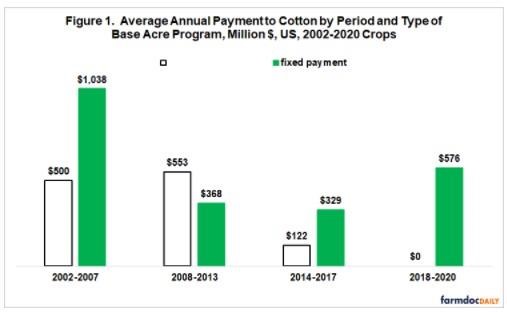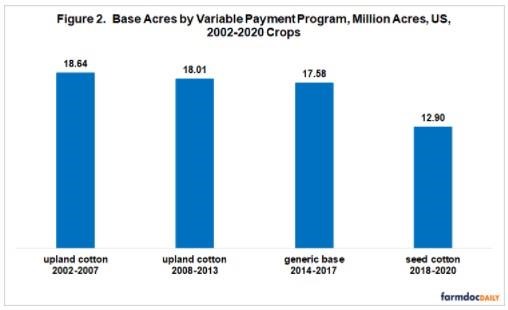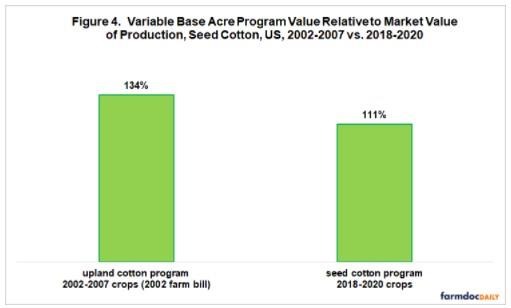By Carl Zulauf
Department of Agricultural, Environmental and Development Economics
Ohio State University
Krista Swanson and Nick Paulson et.al
Department of Agricultural and Consumer Economics
University of Illinois
Cotton is an economically and politically important farm safety net commodity (Coppess). Following its program is thus important to understanding the forces and issues impacting the US farm safety net. This article examines US policy for cotton base acres since 2000. It has taken several turns, some involving all program commodities and some, especially recently, involving only cotton. Both sets of turns are briefly discussed. Changes in payments and base acres are a focus.
Brief History – US Base Acre Policy: Both fixed and variable base acre payment programs have been authorized. Base acre programs making a fixed payment per unit of a program commodity were PFC (Production Flexibility Contract) in the 1996 farm bill and DP (Direct Payment) in the 2002 and 2008 farm bills. Base acre programs making a variable payment were CC (Counter-Cyclical) in the 2002 and 2008 farm bills, ACRE (Average Crop Revenue) in the 2008 farm bill, and ARC (Agriculture Risk Coverage) and PLC (Price Loss Coverage) in the 2014 and 2018 farm bills. CC and PLC made payments when US market year price was below a statutorily determined target or reference price. ACRE and ARC made payments when market revenue was below a benchmark revenue determined in part using historical market revenue.
Brief History – Recent US Cotton Policy: To settle in part Brazil’s WTO (World Trade Organization) case against the 2002 farm bill cotton program, the 2014 farm bill did not authorize ARC and PLC payments for cotton base acres. Instead, it authorized (1) transition direct payments for 2014 and 2015 ($484 and $3 million), and (2) a generic base acre program that allowed ARC or PLC payment to a program commodity planted on former cotton base acres. ARC and PLC payments could thus be received for cotton base but not cotton. For the 2018 market year, Congress designated seed cotton a program commodity and terminated the generic base program. Seed cotton is unginned upland cotton containing lint fiber and seed. Cottonseed is processed into oil or ground for use in cattle, particularly dairy feed. Seed cotton remained a program commodity in the 2018 farm bill.
Payments: Fixed payments to cotton base acres averaged roughly $500 million per year until the 2014 farm bill phased them out (see Figure 1). Variable payments to cotton base were highest during the 2002 farm bill, then declined during the 2008 farm bill as prices rose amid crop prosperity. Generic base payments in 2014-2017 averaged close to variable upland cotton base payments during the 2008 farm bill. While average annual variable payment to seed cotton base lies in the middle, payments have varied markedly by year: $379, $976, and $363 million for 2018, 2019, and 2020, respectively. Payments for 2020 are estimated using current information (see Note 1).

Base Acres: Congress mandated an update of cotton base acres when the seed cotton program was enacted. The update is briefly described in Note 2. Unlike previous updates enacted by Congress, all owners of base acres were not given the option to retain their current base acres. Cotton base acres declined by 4.7 million (-27%) (see Figure 2). Base acres now align more closely with planted acres. Acres planted to seed cotton (i.e. upland cotton) averaged 13.1 million in 2018-2020, nearly identical to seed cotton base. Fewer base acres translate into lower cotton program cost. However, some generic base acres could be and were assigned to other program commodities, reducing the savings in total commodity program cost from updating cotton base. Net savings nevertheless are likely as 2.0 million unassigned generic base acres were reported for the 2018 crop year.

Payment per Base Acre: Variable payments to seed cotton base has averaged $44 per base acre (see Figure 3). This is lower than during the 2002 farm bill but more than double the intervening years.

Program vs. Market Value Indicator: The following ratio was computed to compare the value of program quantity with market value of production for the two highest variable base acre payment periods: 2002-2007 and 2018-2020. Because owners of cotton base have elected price programs far more often than revenue programs, the numerator is the value of CC and PLC program quantity for the earlier and later period, respectively. The 85% factor in the numerator reflects that neither CC nor PLC paid on 15% of base acres. The denominator in both periods is the market value of seed cotton, hence cotton lint and cottonseed. “Indicator” is used because the ratio is not an exact measure of program value, but seeks to capture its main component (see Note 3).
Program vs Market Value indicator = ((US base acres times 85%) times (CC or PLC price) times (US average program yield)) divided by (US production times US market year price)

Ratio of program to market value was lower in 2018-2020 than 2002-2007 by 23 percentage points (134% – 111%) (see Figure 4). The 2002 farm bill’s target price of $0.724 / pound (lb.) of upland cotton translates into a seed cotton target price of $0.362 / lb. using the 0.50 average ratio of seed cotton price to upland cotton lint price for the 2008-2017 crops. Cotton support price is thus roughly the same in both periods; however, seed cotton prices are 39% higher in 2018-2020 than 2002-2007 ($0.326 vs. $0.235). The decline in program support relative to the market is partially offset by the addition of support for cottonseed when the program commodity was changed from upland cotton to seed cotton.
Caution is needed when drawing conclusions from a few observations for a crop whose market value can vary notably from year to year, but this analysis suggests support to cotton by variable base acre programs has declined relative to market value. Nevertheless, seed cotton program value and reference price still exceeded market value and market price in 2018, 2019, and 2020.
Assessment
The return of cotton as a program commodity was accompanied by a base acre update that, unlike prior updates, did not give all owners of base acres the option to retain their base acre at the time of the update. Cotton base acres declined, thus reducing the cost of base acre programs for cotton.
Variable payment per base acre has so far averaged less for seed cotton in 2018-2020 than for upland cotton in 2002-2007 but more than double generic base acres payments in 2014-2017.
Value of program quantity relative to market value of production was lower for seed cotton in 2018-2020 than for upland cotton in 2002-2007. Although number of observations is few, this comparison suggests variable base acre support to cotton relative to market value has declined.
However, program value still exceeded market value of seed cotton in 2018-2020, suggesting US cotton policy will likely remain a subject of interest and scrutiny.
Notes
- Seed cotton’s reference price is $0.3670 / pound (lb.). FSA currently projects a 2020 market year average price (MYAP) of $0.3454 / lb. MYAP was $0.3453 / lb. for 2018 and $0.3058 / lb. for 2019. Base acres for 2019 were 12.95 million with 99% in PLC and average PLC US yield was 1679 lbs. / acre. These program values should be close to the 2020 values since program signup covered 2019 and 2020 crops. A sequestration reduction of 6.5% was used.
- Owners of FSA farms with generic base acres could designate generic base as seed cotton base provided any covered program commodity, including seed cotton, was planted or prevented from being planted on the farm at any time during the 2009-2016 crop years. If this condition was met, seed cotton base was the higher of (a) 80% of generic base acres on the farm or (b) average seed cotton acres planted or prevented from planted during the 2009-2012 crop years, capped at the farm’s generic base acres. Generic base could also be assigned to other program commodities. Remaining generic base were designated “unassigned” base acres for which records are maintained but no payments are made.
- For example, payment limits are not taken into account.
Source : illinois.edu